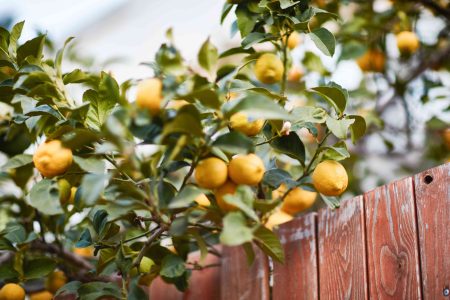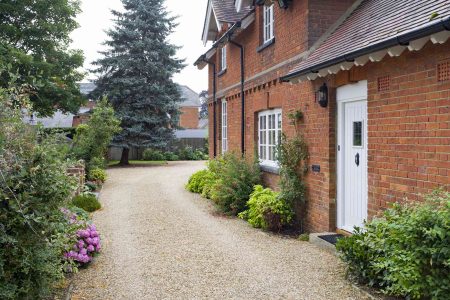Tree trimming improves the health and appearance of trees and is important for the safety of the property and residents. Tree trimming costs range from $215 to $730 per tree. Many factors influence tree trimming costs, including the size of the trees, the number of trees, the type of tree, and the difficulty of the trimming project. On average, tree trimming costs $470 per tree.
Tree Trimming Cost by Size of Tree
The size of the tree is a major factor in estimating the cost of tree trimming because it determines how many workers are needed, whether trained climbers are required, and if special equipment like cranes are required.
Small Trees: Under 20 Feet
The cost to trim a small tree 20 feet high or smaller starts at $85 and ranges up to $345, for an average of $215 per small tree.
Small trees can often be trimmed with a pole trimmer while standing on the ground. Do-it-yourselfers can cut small trees, as well. Small trees include Japanese maples, harlequin gloryblowers, and dawn redwoods.
Medium Trees: 20 to 30 Feet
Trimming a medium-sized tree 20 to 30 feet high ranges from $145 to $485. The average price to trim a medium-sized tree is $315.
Medium trees’ lower branches can be cut with a pole trimmer but usually require a landscaper to climb the tree, often assisted with an extension ladder. Medium-size trees include paper birches, dogwoods, crabapples, and crepe myrtles.
Large Trees: 30 to 50 Feet
The cost to trim a large tree 50 feet high or taller is from $150 to $805. Trimming costs for large trees tend to be on the upper end of the range. The average cost to trim a large tree is $480.
To trim large trees, climbing workers need to be harnessed. A crane may be required to reach upper branches. Large trees include pines, maples, oaks, and spruces.
Extra-Large Trees: 50 Feet or More
Trimming extra-large trees of 50 feet or higher costs from $375 to $1,820, for an average cost of $1,100 to trim an extra-large tree.
Trimming extra-large trees usually involves specialized techniques and equipment, such as harnessed climbers, cranes, and traffic diversion. Extra-large trees include palm trees, oaks, cottonwoods, and most weeping trees such as weeping willows.
Tree Trimming Cost by Type of Tree
- Crepe Myrtle: The cost to trim crepe myrtle trees begins at $82 and ranges up to $455. The average cost to trim a crepe myrtle tree is $270.
- Cypress: Trimming cypress trees start at about $215 and goes up to $1,200. The average cost to trim a cypress tree is $705.
- Oak: Trimming an oak tree ranges from $400 to $1,415, for an average of $910 to trim an oak.
- Palm: The cost to trim a palm tree starts at $210, with an average maximum cost of $1,200. On average, it costs $695 to trim a palm tree.
- Pine: Trimming a pine tree ranges from $275 to $1,715. The average cost to trim a pine tree is about $1,000.
Tree Trimming Cost by Degree of Difficulty
Degree of difficulty is a comprehensive determiner of the cost of tree trimming. Difficulty comprises factors such as the height of the tree, accessibility, the health of the tree, whether there are dead or dying branches, the type of tree, the presence of power lines, structures, or roads, and the need for permits.
Low Difficulty
Low difficulty trees cost from $75 to $300 to trim. Low difficulty trees are generally 20 feet tall or shorter, most of the branches are in good shape, and the tree is fully accessible. On average, it costs $190 to trim a low difficulty tree.
Moderate Difficulty
Moderate difficulty trees cost from $200 to $600 to trim. Moderate difficulty trees are generally from 20 to 30 feet tall, some branches may be in poor shape, dead or diseased, climbing is required, and a structure such as a house or out building is nearby. The average cost to trim a moderate difficulty tree is $400.
High Difficulty
High difficulty trees cost from $600 to $1,800 to trim. High difficulty trees are generally over 30 feet tall, a significant amount of branches may be dead or diseased, sensitive obstacles like high power lines might be nearby, a crane with a bucket is required, a climber with climbing equipment is needed, and traffic diversion is required. On average, it costs $1,200 to trim a high difficulty tree.
Cost by Number of Trees
The more trees that you have cut, the greater the overall cost of the tree trimming project. When developing price estimates, tree maintenance companies will factor in the number of trees.
But additional trees may not always proportionally add to the cost of tree trimming. The cost of each tree trimmed might be less. The company already has workers on the property and equipment such as wood chippers, so subsequent trees may not cost as much as the first tree.
Cost of Labor for Tree Trimming
Homeowners and property owners often turn to the tree maintenance companies for the experience of the crew. When a company quotes a price for tree trimming, the cost of labor is included. The cost of labor for tree trimming ranges from $35 to $70 per hour, per person. On average, labor costs for tree trimming are $55 per hour.
Cost of Tree Topping
The average cost of tree topping begins at $325 and ranges up to an average maximum of $1,070. It generally costs $700 to top a tree.
Tree topping is the process of cutting between tree branches to lower the height of the tree, almost to the trunk. Topping is less expensive than full removal, and it’s often a quick fix for problem trees or for trees that exhibit the sail effect. Poorly topping a tree can kill the tree. Often, a better alternative is crown reduction or pollarding the tree.
Cost of Permits for Tree Trimming
The cost of permits for tree removal averages $500 per tree. Permits to trim trees usually cost less than permits for full removal or may not be required.
Tree trimming, pruning, or removal in cities and other incorporated areas may be a regulated activity that requires a permit. Some areas do not permit tree topping or the removal of trees near watersheds, unless deemed hazard trees.
Established to monitor and slow the loss of tree canopies, tree canopy regulations help create sustainable urban forests to mitigate erosion, reduce water runoff, improve air quality, and preserve property values.
Cost to Hire an Arborist
A tree arborist will cost from $90 to $120 per hour, for an average of about $100 per hour.
The qualified opinion of an arborist may be necessary to decide if a tree needs to be trimmed and how it should be trimmed. When issuing permits, municipalities often require an arborist’s official opinion for removing a tree or for making major cuts to a tree.
Cost of Tree Removal
Removing a tree starts at $305 and ranges up to $1,110 per tree, for an average tree removal cost of $710.
Tree removal down to the stump may be done along with trimming other trees. Removing trees allows other trees to thrive by removing competing root systems.
Cost of Yard Cleanup After Tree Trimming
The cost to clean up a yard after tree trimming starts at $125 and ranges up to $400, for an average of $265.
Cleaning up a yard by yourself after tree trimming is one way to save on the cost of tree trimming. But it’s important not to underestimate the scale of cutting up and disposing of large limbs after tree trimming. Work crews have tools like chainsaws and wood chippers that make the job go easier.
Cost of Log Splitting After Tree Trimming
The cost to split cut limbs into logs appropriate for burning costs from $35 to $100 per cord. On average, it costs $70 per cord to split logs.
Signs That a Tree Should be Trimmed
Trees can be trimmed for aesthetic reasons, but in many cases it can be a necessity to trim the tree. Dead wood, decayed wood, and poor proportion are a few of the signs that a tree should be trimmed.
- Dead wood: Dead wood on a tree should always be trimmed since it will never grow back and it is a hazard. If the entire tree is dead, it should be removed.
- Decay: Decay may be within the tree, disguised by bark overgrowth. An arborist can help determine if there is hidden decay in the tree.
- Large cracks: Splits in a tree indicate that a limb or the tree itself may come apart. The tree should be trimmed back to the split.
- Poor tree structure: Trees that are out of proportion are at greater risk of falling or limbs being damaged. Poorly structured trees can be reshaped for symmetry.
- Damaging pests: Woodpecker damage or damage from other invasive pests like termites or emerald ash borers. Since woodpeckers are cavity-nesting birds, they can often indicate decay within the tree.
DIY vs. Professional Tree Trimming
With the right tools and safety equipment, homeowners can trim their own trees. Owning a step ladder, pole trimmer, pruning saw, pruning clippers, and an electric or gas-powered chainsaw help you cut your own trees or supplement visits from the tree trimming company.
Beyond simple trimming and pruning, though, it’s best to call a qualified tree maintenance company. Trimming trees can look deceptively safe and simple. But tree limbs or entire trees can fall in unexpected directions, toward people, power lines, or structures. Beyond the issue of safety, professionals know where and how to cut tree limbs to avoid causing health problems for the trees.
All tree trimming jobs that require climbing should be done by trained professionals. Leave tree-felling to the pros, as well.
DIY Tree Trimming Costs
- Loppers: $30 to $50
- Pruning saw: $20 to $30
- Ladder: $150 to $250
- Electric chainsaw: $100 to $200
- Pole trimmer: $75 to $150
- Safety glasses: $10 to $20
- Gloves: $10 to $20
Purchasing a basic set of tree trimming tools adequate for trimming small trees costs from $395 to $725. On average, a good, but limited, set of tree trimming tools will cost $560.
The DIY cost to trim a single tree is $560 if all tools need to be purchased. More trees can be cut with the same tools, reducing the per-tree cost of DIY tree trimming with additional trees. So, the DIY cost to trim five trees would be about $110 per tree.
Tree Trimming vs. Tree Pruning
Tree pruning, as opposed to tree trimming, costs from $290 to $1,070, for an average of $680 to prune a tree.
Tree trimming removes tree overgrowth to keep the trees well-shaped, uniform in size, and in check, so that they don’t grow into unwanted areas like the roof or in power lines.
Tree pruning is more focused on the health of the tree by removing unwanted or diseased areas that may limit tree growth or kill it altogether.
Both tree trimming and tree pruning require experience to know where to make the cut or whether a cut should even be made. The same professionals who do tree trimming maintenance work can often prune the trees, too.
7 Ways to Save on the Cost of Tree Trimming
- Maintain the trees regularly: Keep the trees well-maintained and their size in check. Larger trees become exponentially more expensive since crane-assisted tree removal may be necessary.
- Get informed opinions: As part of the sales process, tree maintenance salespeople may note trees on your property that are unhealthy or that need trimming. Be sure to get an opinion from their tree inspector or from an arborist.
- Call the power company to cut the trees: Power companies typically trim vegetation growing near power lines. The trees are inspected by arborists and cut by trained professionals. The power company can send an inspector to your property if you believe your tree is close enough to power equipment for free tree trimming.
- Verify if your insurance will cover the cost: While most homeowner’s insurance policies will not cover preemptive tree care, they will pay for tree removal and cleanup if a tree falls on your property.
- Ask for proof of the company’s insurance: The tree maintenance company should have general liability insurance. If an uninsured company causes damage or a worker is injured, you may need to pay for the costs out-of-pocket or take the company to court to recover the damages.
- Trim several trees in one project: While additional trees add to the tree trimming cost, the cost will usually be less than if you trimmed the trees one at a time.
- Clean up the yard yourself: Tree maintenance companies may charge an extra fee for yard cleanup. If so, save costs by cutting up limbs by yourself. You can save about $265 by cleaning up the yard by yourself.
-
What is the best time to trim trees?
Depending on the area, the best time to trim trees is usually the dormant season. This season extends from when all leaves have fallen from the trees (around October or November) to early spring (March or April), when the buds begin to develop on the trees again. The trees have less mass, so there is less to cut and haul away. Plus, it’s easier to inspect the trees with the leaves gone.
-
How much can you trim from a tree without hurting it?
Trim no more than 25% of live foliage from mature trees. Trimming more than this amount will stress the tree’s system. Most tree professionals recommend cutting less than this—up to 10- to 15%.
-
How much does it cost to top a large tree?
The cost of tree topping starts at $325 and ranges up to $1,070, for an average of about $700 to top a tree. Topping a large tree would cost in the upper end of the price range.
Read the full article here














